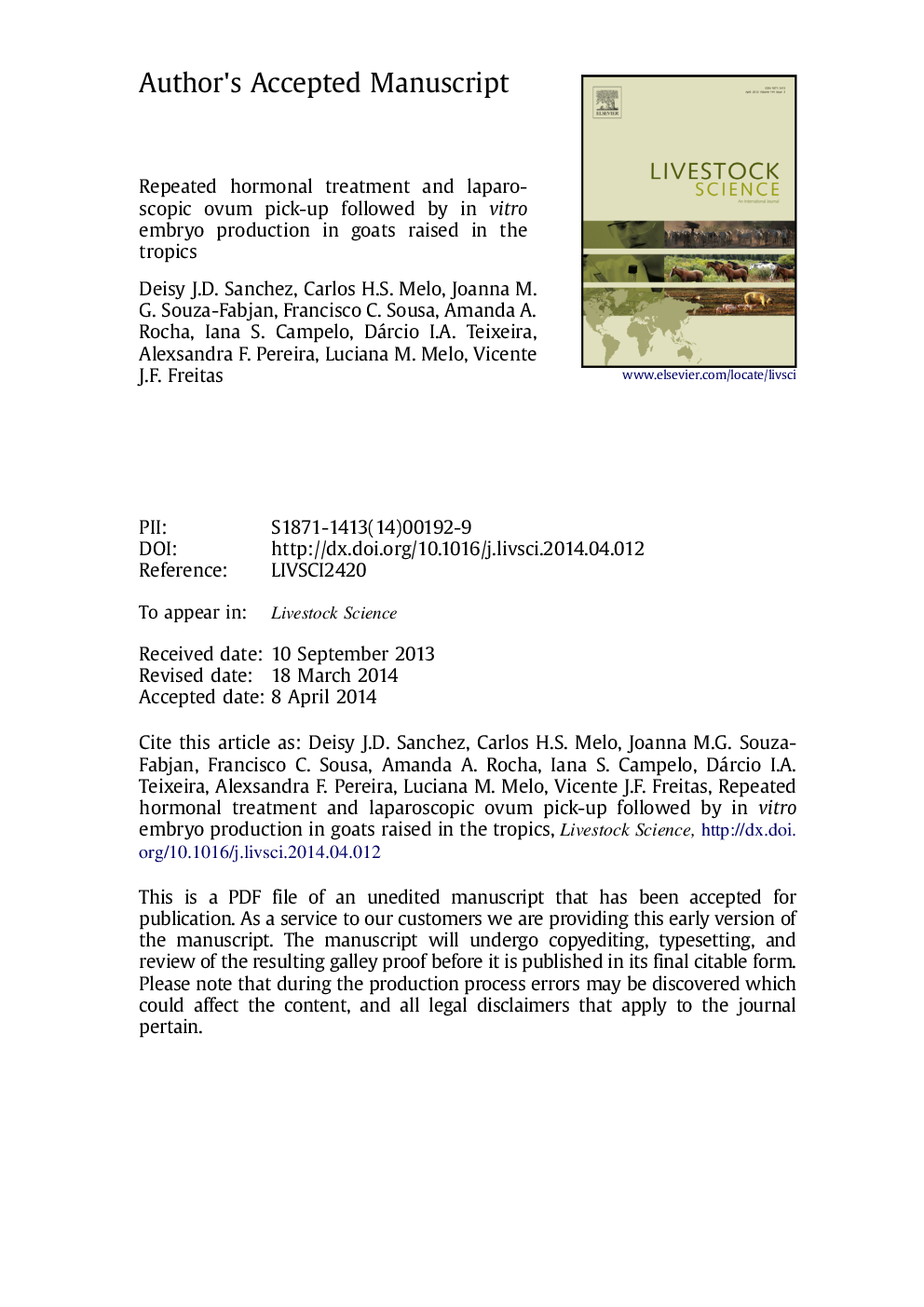| Article ID | Journal | Published Year | Pages | File Type |
|---|---|---|---|---|
| 5790118 | Livestock Science | 2014 | 21 Pages |
Abstract
The objectives of this study were to evaluate the ovarian response of oocyte donor goats which underwent seven repeated ovulation hormonal treatments and laparoscopic ovum pick-up (Experiment 1), and to compare the In vitro production (IVP) of embryos from goats hormonally treated for eighth time to IVP of embryos from females with a single hormonal treatment (Experiment 2). In Experiment 1, 12 goats were subjected to 7 repeated hormonal treatments and laparoscopic ovum pick-up (LOPU) every 2-3 weeks, and the following variables were recorded: number and size of punctured follicles, number of recovered cumulus-oocyte complexes (COCs), recovery rate and COCs quality. In Experiment 2, IVP of embryos from goats hormonally treated for eighth time (repeated-treated group, RT) was compared with IVP of embryos from 10 other goats with only one hormonal treatment (single-treated group, ST). In this step, in addition to variables observed in Experiment 1, cleavage, blastocyst rates at Days 7 and 8 of culture, hatched rate and the number of blastomeres per embryo were also evaluated. In Experiment 1, when comparing LOPU sessions, no difference (P>0.05) was verified for number of punctured follicles, number of recovered COCs and recovery rate. However the percentage of large follicles was different (P<0.05) between LOPU 1 (27.7±10.5) and 7 (12.4±12.1), the latter being similar to sessions 2 (13.9±10.9), 3 (13.4±7.9), 4 (13.2±10.7), 5 (22.4±14.7) and 6 (17.7±15.8). The percentage of COCs suitable for IVM was lower (P<0.05) for LOPU 1 (80.6%), 2 (82.4%) and 3 (79.7%) than LOPU 6 (91.3%) and 7 (95.2%). In Experiment 2, total number of follicles aspirated/goat and total number of COCs recovered were similar (P>0.05) for RT (18.0±5.8 and 12.3±3.7, respectively) and ST (19.4±7.8 and 15.8±7.7, respectively) groups. However, the recovery rate was lower (P<0.05) in the RT vs the ST group (68.5% and 81.4%). The percentage of small, medium and large follicles was similar (P>0.05), respectively, for RT (28%, 55% and 17%) and ST (20%, 65% and 15%) groups. The percentage of COCs suitable for IVM had no difference (P>0.05) for RT (96.6%) and ST (93.7%) groups. No significant difference was observed between RT and ST groups for: cleavage rate (68.6% vs 67.0%), blastocyst rate at Days 7 (27.9% vs 31.8%) and 8 (27.9% vs 34.1%), hatched rate (33.3% vs 53.3%), and blastomeres/embryo (252.9 vs 229.8). In conclusion, in goats raised in tropical climate, the IVP of embryos from oocytes obtained by LOPU could be an efficient and suitable method for rapid propagation of genetically superior animals. Donor goats, even after repeated hormonal treatments followed by LOPU, maintained the ovarian response for oocyte and embryo production, becoming close to reality the term “oocyte permanent donors”.
Related Topics
Life Sciences
Agricultural and Biological Sciences
Animal Science and Zoology
Authors
Deisy J.D. Sanchez, Carlos H.S. Melo, Joanna M.G. Souza-Fabjan, Francisco C. Sousa, Amanda A. Rocha, Iana S. Campelo, Dárcio I.A. Teixeira, Alexsandra F. Pereira, Luciana M. Melo, Vicente J.F. Freitas,
